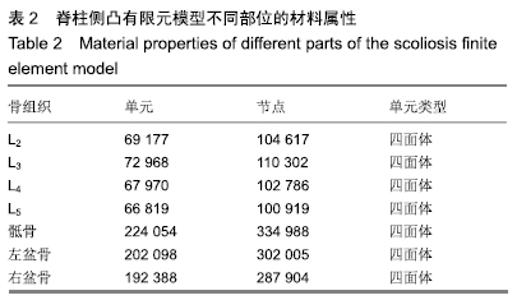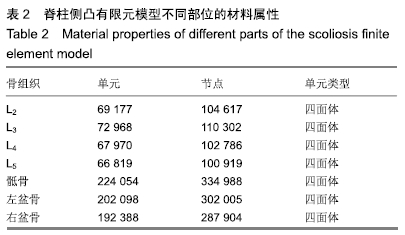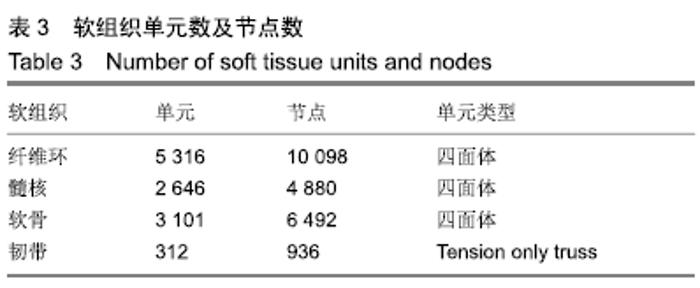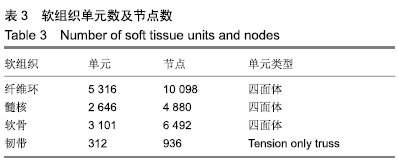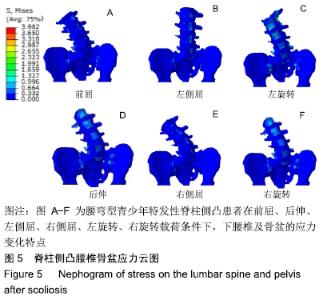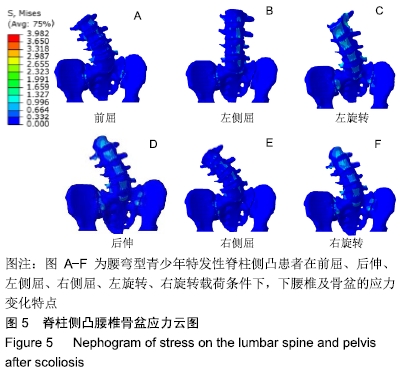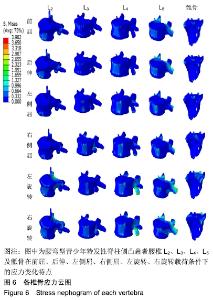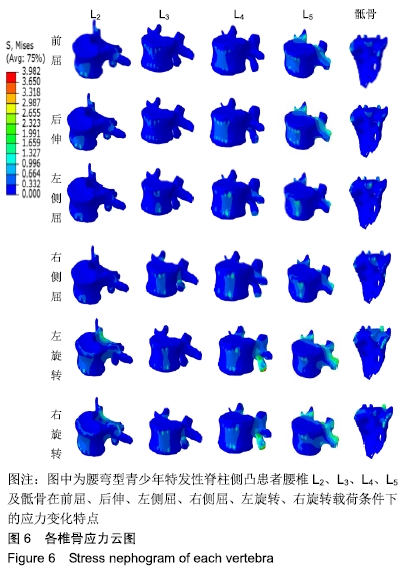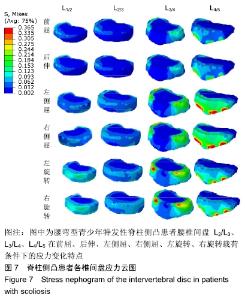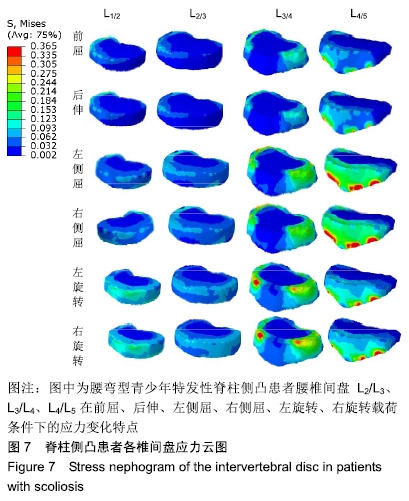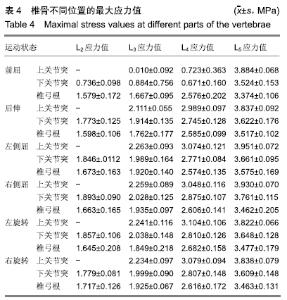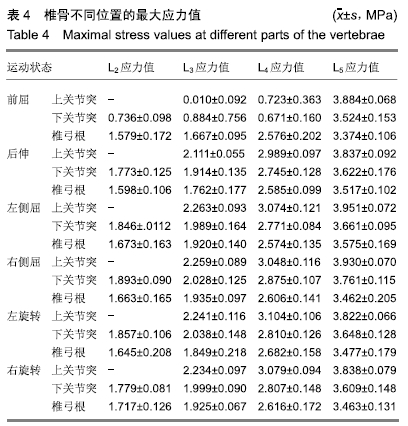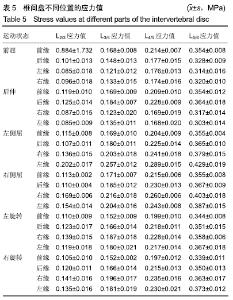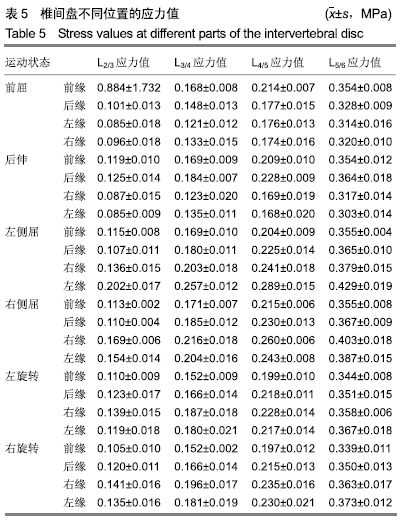Chinese Journal of Tissue Engineering Research ›› 2020, Vol. 24 ›› Issue (8): 1155-1161.doi: 10.3969/j.issn.2095-4344.2468
Previous Articles Next Articles
Biomechanical analysis of the lumbar spine and pelvis in adolescent
idiopathic scoliosis with lumbar major curve
Zhang Cong1, Zhao Yan2, Du Xiaoyu1, Du Xinrui1, Pang Tingjuan1, Fu Yining1, Zhang Hao1, Zhang Buzhou1, Li Xiaohe3, Wang Lidong4
- 1Inner Mongolia Medical University; 2Department of Orthopedics, the Second Affiliated Hospital of Inner Mongolia Medical University; 3Laboratory of Anatomy, School of Basic Medical Sciences, Inner Mongolia Medical University; 4Inner Mongolia International Mongolia Hospital, Hohhot 010110, Inner Mongolia Autonomous Region, China
-
Received:2019-01-21Revised:2019-01-29Accepted:2019-03-18Online:2020-03-18Published:2020-01-21 -
Contact:Li Xiaohe, MD, Professor, Master’s supervisor, Laboratory of Anatomy, School of Basic Medical Sciences, Inner Mongolia Medical University, Hohhot 010110, Inner Mongolia Autonomous Region, China Wang Lidong, MD, Chief physician, Master’s supervisor, Inner Mongolia International Mongolia Hospital, Hohhot 010110, Inner Mongolia Autonomous Region, China -
About author:Zhang Cong, Inner Mongolia Medical University, Hohhot 010110, Inner Mongolia Autonomous Region, China Zhao Yan, MD, Chief physician, Master’s supervisor, Department of Orthopedics, the Second Affiliated Hospital of Inner Mongolia Medical University, Hohhot 010110, Inner Mongolia Autonomous Region, China Zhang Cong and Zhao Yan contributed equally to this work. -
Supported by:the National Natural Science Foundation of China, No. 81460330; the Science and Technology Project for the Young Talents of Education Department of Inner Mongolia Autonomous Region, No. njyt-15-b05; the Science and Technology Program of Inner Mongolia Autonomous Region, No. 2016; the Science and Technology Innovation Guidance Project of Inner Mongolia Autonomous Region, No. 2017; the Natural Science Foundation of Inner Mongolia Autonomous Region, No. 2016ms08131; the Returned Overseas Foundation of Department of Human Resources and Social Security of Inner Mongolia Autonomous Region, No. 201620
CLC Number:
Cite this article
Zhang Cong, Zhao Yan, Du Xiaoyu, Du Xinrui, Pang Tingjuan, Fu Yining, Zhang Hao, Zhang Buzhou, Li Xiaohe, Wang Lidong.
Biomechanical analysis of the lumbar spine and pelvis in adolescent
idiopathic scoliosis with lumbar major curve
share this article
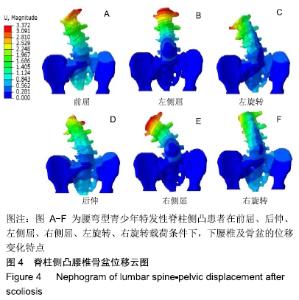
2.2 三维有限元模型的验证 由于脊柱侧凸的角度各不相同,没有公认的验证标准,故对正常脊柱腰骶验证的方法对于脊柱侧凸腰骶椎建模同样有效。此模型在前屈、后伸、侧屈、旋转作用下的平均刚度值与以往文献报道中模型的平均刚度值的比较结果基本吻合,因此所建的三维有限元模型是有效可靠的,可以应用于临床研究[16]。 2.3 韧带对脊柱承载能力的影响 各椎骨间借韧带、软骨和滑膜关节相连,有限元模型中建立的前纵韧带、后纵韧带、黄韧带、关节囊韧带、横突间韧带、棘间韧带、棘上韧带、髂腰韧带、骶髂前韧带、骶髂后韧带,在脊柱承载前屈、后伸、左侧屈、右侧屈、左旋转、右旋转载荷时均能够承担一部分载荷[17]。其中前纵韧带、后纵韧带、黄韧带、棘上韧带对施加载荷后脊柱的运动起着尤为重要的作用。前纵韧带是椎体前面延伸的一束坚固的纤维束,有防止脊柱过度后伸的作用;后纵韧带位于椎管内椎体的后面,窄而坚韧,有限制脊柱过度前屈的作用;黄韧带位于椎管内,连结相邻两椎弓板间,有限制脊柱过度前屈的作用;棘上韧带是连结胸、腰、骶椎各棘突尖之间的纵行韧带,有限制脊柱前屈的作用。此次研究中未建立的肌肉也可承担载荷[18],维持脊柱姿态。且竖脊肌一侧收缩使脊柱向同侧屈,两侧同时收缩使脊柱后伸和仰头;腹肌前外侧群包括腹外斜肌、腹内斜肌等使脊柱前屈、侧屈及旋转;后群为腰方肌使脊柱侧屈。 2.4 青少年特发性脊柱侧凸患者腰椎骨盆模型位移云图变化 由位移云图可知,青少年特发性脊柱侧凸腰主弯模型在6种工况下(前屈后伸,左右侧屈及左右旋转),L1椎体上部在左、右侧屈时位移变化最大,骶骨下端在前屈时位移最大,见图4。 "
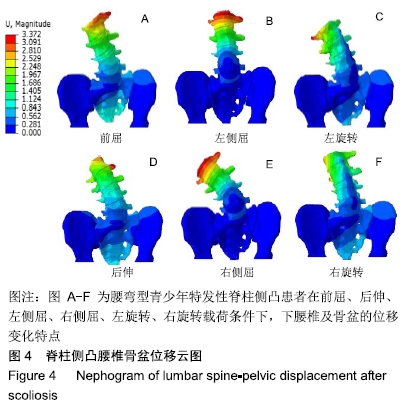
| [1] KALICHMAN L, KENDELKER L, BEZALEL T.Bmcing and exercisebased treatment for idiopathic scoIiosis. J Bodyw Mov Thel. 2016;20(1):56-64. [2] LO YF, HUANG YC. Bracing in adolescent idiopathic scoliosis. Hu Li Za Zhi. 2017; 64(2): 117-123. [3] 周璇,杜青,梁菊萍,等.脊柱侧凸特定运动疗法治疗轻度青少年特发性脊柱侧凸患者的疗效观察[J].中华物理医学与康复杂志,2016,38(12):927-932. [4] SKIBINSKA I, TOMASZEWSKI M, ANDRNSIEWICZ M, et al. Expression of estrogen receptor coactivator proline-,glutamic acid-and leucine-rich protein l within paraspinal muscles in adolescents with idiopathic scoliosis.Phs One. 2016;11(4): e0152286. [5] ZAPATA KA, WANG-PRICE SS, SUCATO DJ, et al. Uhrasonographie measurements of paraspinal muscle thickness in adolescent idiopathic scoliosis:a comparison and reliability study.Pediatr Phys Ther. 2015; 27(2):119-125. [6] YAGI M, MACHIDA M, ASAZUMA T. Pathogenesis of adolescent idiopathic scoliosis. JBJS Rev. 2014;2(1). pii: 01874474-201401000-00004. [7] STOKES IA. Mechanical effects on skeletal growth. J Musculoskelet Neuronal Interact.2002;2(3):277-280. [8] NODA M, SAEQUSA Y, TAKAHASHI M, et al. Biomechanical study using the finite element method of internal fixation in Pauwels type vertical femoral neck fractrues. Arch Trauma Res. 2015;4(3): e23167. [9] LI J, ZHAO X, HU X, et al. A theoretical analysis and finite element simulation of fixator-bone system stiffness on healing progression. J Appl Biomater Funct Mater. 2018;16(3): 115-125. [10] CHEUNG JPY, YIU KKL, VIDYADHARA S. Predictability of supine radiographs for determining in-brace correction for adolescent idiopathic scoliosis. Spine (Phila Pa 1976). 2018;43(14):971-976. [11] GOEL VK,KONG W,HAN JS,et al. A combined finite element and optimization investigation of lumbar spine mechanics with and without muscles. Spine. 1993;18(11):1531-1541. [12] 闫家智,吴志宏,徐日新,等.腰椎后路单节段椎弓根螺钉内固定的三维有限元分析[J].中华医学杂志,2009,89(1):7-11. [13] POLIKEIT A, FERGUSON SJ, NOLTE LP, et al. Factors influencing stresses in the lumbar spine after the insertion of intervertebral cages:finite element analysis. Eur Spine J. 2003;12(4):413-420. [14] SYLVESTRE PL, VILLEMURE I, AUBIN CE. Finite element modeling of the growth plate in a detailed spine model. Med Biol Eng Comput. 2007;45(10):977-988. [15] JIN XZ, HOMAEI E, MATINLINNA JP, et al. A mew concept and finite-element study on dental bond sreength test. Dent Mater. 2016; 32(10):e238-250. [16] HETH JA, HITCHON PW, GOEL VK, et al. A biomechanical comparison between anterior and transverse interbody fusion cages. Spine. 2001;26(12):e261-e267. [17] 晏礼,宋文慧,王春强,等.胸腰段脊柱有限元模型的建立及 其生物力学分析[J].中国临床研究,2013,26(7):629.631. [18] PARK SK, YANG DJ, KIM JH, et al. Analysis of mechanical properties of cervical muscles in patients with cervicogenic headache.J Phys Ther Sci. 2017;29(2):332-335. [19] 文毅,苏峰,刘肃,等.L4-5椎体有限元模型建立及退变椎间盘力学分析[J].中国组织工程研究,2019,23(8):1222-1227. [20] ZADPOOR AA, WEINANS H. Patient-specific bone modeling and analysis: the role of integration and automation in clinical adoption. J Biomech. 2015;48(5):750-756. [21] YUENYONGVIWAT V, IAMTHANAPORN K, HARNROONGROJ T. Radiographic manifestation of hip dislocation after total hip arthroplasty. J Med Assoc Thai. 2014;97(1):60-63. [22] SHI D, WANG F, WANG D, et al. 3-D finite element analysis of the influence of synovial condition in sacroiliac joint on the load transmission in human pelvic system. Med Eng Phys. 2014;36(6): 745-753. [23] GUO LX, LI R, ZHANG M. Biomechanical and fluid flowing characteristics of intervertebral disc of lumbar spine predicted by poroelastic finite element method. Acta Bioeng Biomech. 2016;18(2):19-29. [24] IVANCIC PC. Biomechanics of thoracolumbar burst and chance- type fractures during fall from height. Global Spine J. 2014;4(3):161-168. [25] DU CF, YANG N, GUO JC, et al.Biomechanical response of lumbar facet joints under follower preload:a finite element study. BMC Musculoskelet Disord. 2016;17(1):126. [26] CLAESON AA, BAROCAS VH. Computer simulation of lumbar flexion shows shear of the facet capsular ligament. Spine J. 2017;17(1): 109-119. [27] WANG L, ZHANG B, CHEN S, et al. A validated finite element analysis of facet joint stress in degenerative lumbar scoliosis. World Neurosurg. 2016;95(11):126-133. [28] MC AP, CUNNINGHAM B, MULLINEX K, et al. Middle-Column Gap Balancing and Middle-Column Mismatch in Spinal Reconstructive Surgery. Int J Spine Surg. 2018;12(2):160-171. [29] MCAFEE PC, EISERMAN L, CUNNINGHAM BW, et al. Middle column gap balancing to predict optimal anterior structural support and spinal height in spinal reconstructive surgery. Spine (Phila Pa 1976). 2017;42 Suppl 7:S19-S20. [30] SUGAYA T, SAKAMOTO M, NAKAZAWA R, et al. Relationship between spinal range of motion and trunk muscle activity during trunk rotation. J Phys Ther Sci. 2016;28(2):589-595. [31] KAKU N, HARA K, TABATA T, et al. Influence of the volume of bone defect, bone grafting methods, and hook fixation on stress on the Kerboull-type plate and screw in total hip arthroplasty: three-dimensional finite element analysis. Eur J Orthop Surg Traumatol. 2015;25(2):321-329. [32] HUA X, WANG L, AL-HAJJAR M, et al.Experimental validation of finite element modelling of a modular metal-on-polyethylene total hip replacement. Proc Inst Mech Eng H. 2014;228(7): 682-692. [33] LERCH M, WEIGEL N, WINDHAGEN H, et al. Finite element model of a novel short stemmed total hip arthroplasty implant developed from cross sectional CT scans. Technol Health Care. 2013;21(5):493-500. [34] COOK D, JULIAS M, NAUMAN E. Biological variability in biomechanical engineering research: Significance and meta-analysis of current modeling practices. J Biomech. 2014;47(6):1241-1245. [35] SANTIAGO JUNIOR JF, VERRI FR, ALMEIDA DA, et al. Finite element analysis on influence of implant surface treatments, connection and bone types. Mater Sci Eng C Mater Biol Appl. 2016;63: 292-300. [36] 苏少亭,苏少亭,周红海,等.腰椎关节突关节的生物力学研究进展[J].中国脊柱脊髓杂志,2017,27(5):474-479. [37] DREISCHARF M, ZANDER T, SHIRAZI-ADL A, et al. Comparison of eight published static finite element models of the intact lumbar spine: predictive power of models improves when combined together. J Biomech. 2014; 47(8):1757-1766. [38] HATTORI-HARA E, MITSUI SN, MORI H, et al. Influence of unilateral disc displacement on stress in the contralateral joint with a normally positioned disc in human temporomandibular joint: An analytic approach using the finite element method. J Cranio Maxillofacial Surg. 2014;42(8):2018-2024. [39] CHEN YC, TU YK, ZHUANG JY, et al. Evaluation of the parameters affecting bone temperature during drilling using a three - dimensional dynamic elastoplastic finite element model. Med Biol Eng Comput. 2017;55(11):1949-1957. [40] WU W, CHEN C, NING J, et al. A novel anterior trans-pedicular screw artificial vertebral body system for lower cervical spine fixation: A finite element study. J Biomech Eng. 2017. [41] MALLETT K, ARRUDA EM. Digital image correlation-aided mechanical characterization of the anteromedial and posterolateral bundles of the anterior cruciate ligament. Acta Biomaterialia. 2017;56: 44. [42] ZADPOOR AA,WEINANS H.Patient-specific bone modeling and analysis:the role of integration and automation in clinical adoption. J Biomech. 2015;48(5): 750-756. |
| [1] | Xu Feng, Kang Hui, Wei Tanjun, Xi Jintao. Biomechanical analysis of different fixation methods of pedicle screws for thoracolumbar fracture [J]. Chinese Journal of Tissue Engineering Research, 2021, 25(9): 1313-1317. |
| [2] | Lu Dezhi, Mei Zhao, Li Xianglei, Wang Caiping, Sun Xin, Wang Xiaowen, Wang Jinwu. Digital design and effect evaluation of three-dimensional printing scoliosis orthosis [J]. Chinese Journal of Tissue Engineering Research, 2021, 25(9): 1329-1334. |
| [3] | Yao Rubin, Wang Shiyong, Yang Kaishun. Minimally invasive transforaminal lumbar interbody fusion for treatment of single-segment lumbar spinal stenosis improves lumbar-pelvic balance [J]. Chinese Journal of Tissue Engineering Research, 2021, 25(9): 1387-1392. |
| [4] | Chen Xinmin, Li Wenbiao, Xiong Kaikai, Xiong Xiaoyan, Zheng Liqin, Li Musheng, Zheng Yongze, Lin Ziling. Type A3.3 femoral intertrochanteric fracture with augmented proximal femoral nail anti-rotation in the elderly: finite element analysis of the optimal amount of bone cement [J]. Chinese Journal of Tissue Engineering Research, 2021, 25(9): 1404-1409. |
| [5] | Zhou Jihui, Li Xinzhi, Zhou You, Huang Wei, Chen Wenyao. Multiple problems in the selection of implants for patellar fracture [J]. Chinese Journal of Tissue Engineering Research, 2021, 25(9): 1440-1445. |
| [6] | Liu Yafei, Wang Yalin, Zuo Yanping, Sun Qi, Wei Jing, Zhao Lixia. Structural changes of the temporomandibular joint in adolescents with skeletal Class III malocclusions after maxillary protraction: an X-ray measurement analysis [J]. Chinese Journal of Tissue Engineering Research, 2021, 25(8): 1154-1159. |
| [7] | Xu Yulin, Shen Shi, Zhuo Naiqiang, Yang Huilin, Yang Chao, Li Yang, Zhao Heng, Zhao Lu. Biomechanical comparison of three different plate fixation methods for acetabular posterior column fractures in standing and sitting positions [J]. Chinese Journal of Tissue Engineering Research, 2021, 25(6): 826-830. |
| [8] | Cai Qunbin, Zou Xia, Hu Jiantao, Chen Xinmin, Zheng Liqin, Huang Peizhen, Lin Ziling, Jiang Ziwei. Relationship between tip-apex distance and stability of intertrochanteric femoral fractures with proximal femoral anti-rotation nail: a finite element analysis [J]. Chinese Journal of Tissue Engineering Research, 2021, 25(6): 831-836. |
| [9] | He Li, Tian Wei, Xu Song, Zhao Xiaoyu, Miao Jun, Jia Jian. Factors influencing the efficacy of lumbopelvic internal fixation in the treatment of traumatic spinopelvic dissociation [J]. Chinese Journal of Tissue Engineering Research, 2021, 25(6): 884-889. |
| [10] | Song Chengjie, Chang Hengrui, Shi Mingxin, Meng Xianzhong. Research progress in biomechanical stability of lateral lumbar interbody fusion [J]. Chinese Journal of Tissue Engineering Research, 2021, 25(6): 923-928. |
| [11] | Liu Zhao, Xu Xilin, Shen Yiwei, Zhang Xiaofeng, Lü Hang, Zhao Jun, Wang Zhengchun, Liu Xuzhuo, Wang Haitao. Guiding role and prospect of staging and classification combined collapse prediction method for osteonecrosis of femoral head [J]. Chinese Journal of Tissue Engineering Research, 2021, 25(6): 929-934. |
| [12] | Pan Qile, Zhang Hong, Zhou Huikang, Cai Guang. Comparison of the Greulich-Pyle method, the CHN method and the China 05 method for assessing bone age in children and adolescents [J]. Chinese Journal of Tissue Engineering Research, 2021, 25(5): 662-667. |
| [13] | Xie Chongxin, Zhang Lei. Comparison of knee degeneration after anterior cruciate ligament reconstruction with or without remnant preservation [J]. Chinese Journal of Tissue Engineering Research, 2021, 25(5): 735-740. |
| [14] | Zhou Jihui, Li Xinzhi, Zhou You, Huang Wei, Chen Wenyao. Comparison of the advantages and disadvantages of multiple implants in treatment of traumatic dislocation of sternoclavicular joint [J]. Chinese Journal of Tissue Engineering Research, 2021, 25(3): 443-448. |
| [15] | Nie Shaobo, Li Jiantao, Sun Jien, Zhao Zhe, Zhao Yanpeng, Zhang Licheng, Tang Peifu. Mechanical stability of medial support nail in treatment of severe osteoporotic intertrochanteric fracture [J]. Chinese Journal of Tissue Engineering Research, 2021, 25(3): 329-333. |
| Viewed | ||||||
|
Full text |
|
|||||
|
Abstract |
|
|||||
